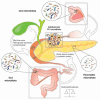The Human Microbiomes in Pancreatic Cancer: Towards Evidence-Based Manipulation Strategies?
- PMID: 34576078
- PMCID: PMC8471697
- DOI: 10.3390/ijms22189914
The Human Microbiomes in Pancreatic Cancer: Towards Evidence-Based Manipulation Strategies?
Abstract
Recent pieces of evidence have emerged on the relevance of microorganisms in modulating responses to anticancer treatments and reshaping the tumor-immune microenvironment. On the one hand, many studies have addressed the role of the gut microbiota, providing interesting correlative findings with respect to etiopathogenesis and treatment responses. On the other hand, intra-tumoral bacteria are being recognized as intrinsic and essential components of the cancer microenvironment, able to promote a plethora of tumor-related aspects from cancer growth to resistance to chemotherapy. These elements will be probably more and more valuable in the coming years in early diagnosis and risk stratification. Furthermore, microbial-targeted intervention strategies may be used as adjuvants to current therapies to improve therapeutic responses and overall survival. This review focuses on new insights and therapeutic approaches that are dawning against pancreatic cancer: a neoplasm that arises in a central metabolic "hub" interfaced between the gut and the host.
Keywords: immuno-oncology; microbiome; pancreatic cancer; tumor-targeting bacteria.
Conflict of interest statement
The authors declare no conflict of interest.
Figures
References
Publication types
MeSH terms
LinkOut - more resources
Full Text Sources
Medical



